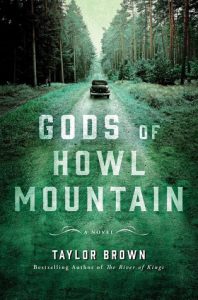Secrets are Held Closely in the Mountains

Granny May Docherty lost her daughter Bonni to Dix Hill 30 years ago when nightriders killed her boyfriend, the mill owner’s son Conner, silencing her voice. Her grandson Rory lost his leg to Korea, limiting his employment opportunities on his return home, leaving him little choice but to become a whiskey runner for Eustace Uptree, his best friend’s uncle and Granny May’s lover. Brown takes readers through the rabbit hole away from Mad Men and the American dream of a white picket fence to the colorful and dangerous world of Appalachia, where reigned illegal whiskey and wannabe drivers for the newly founded NASCAR.
A middle-aged wood witch and former prostitute, Granny May longs to know who hurt her girl, but fear of consequences prevents her from pursuing it with Rory. Brown’s subtle backstory of Bonni and Conner’s romance contrasts with the rawness and graphic depiction of mountain life in the 50s. Flooding of mountain valleys for “progress” disrupted Appalachian culture and forced a reluctant relationship with those living in towns and cities. Amy Greene’s “Long Man” shows the resistance of one woman against such flooding by the government. In Brown’s story, the event is long-reaching, since the main road literally heads straight into the man-made lake. As in Amy Greene’s debut novel “Bloodroot,” a body part is used as symbolism of a South yet alive with Pagan ways while tightly holding its secrets.
Taylor Brown digs out niches in his historical fiction—last vestiges of whiskey runners and nascent NASCAR, river kings, the lawlessness at the end of the civil war—getting down to the nitty-gritty of hard-living, developing complex characters who maintain their integrity in impossible situations. He gets a bit too “real” sometimes; for instance, there’s a lot of spitting in this book, some of it from Granny May—so much spitting. In one scene, Eustace flicks his nephew in the nuts. Graphic details can overwhelm the reader, such as when Rory’s rival purposely hits a deer and Brown describes the specifics of the deer’s physical suffering. Having said that, the reader leaves the novel with a sense of having learned history not found in textbooks, such as exactly what someone who drives illegal booze through the mountains does to his car to outrun the revenuers. It’s a definite must-read.